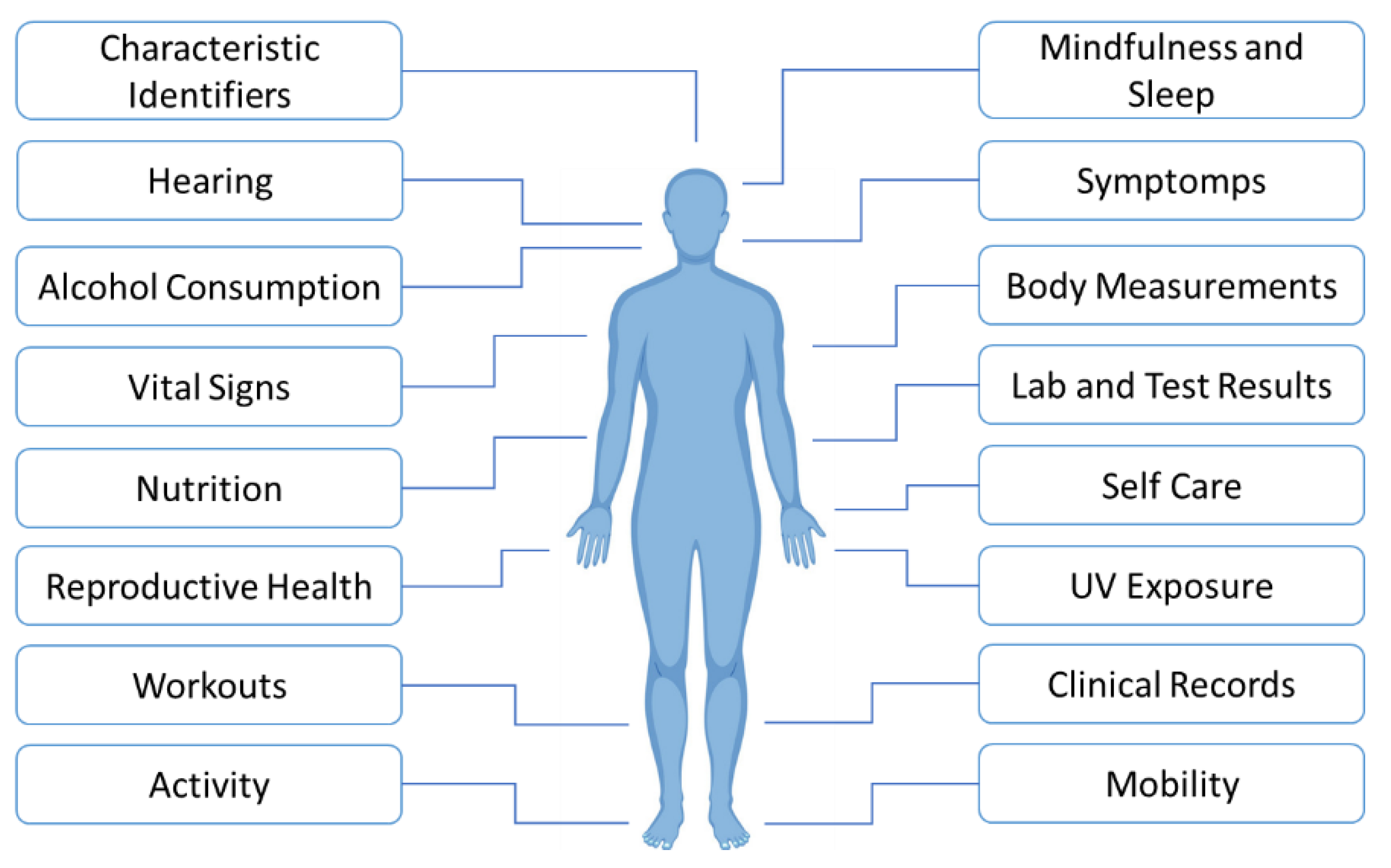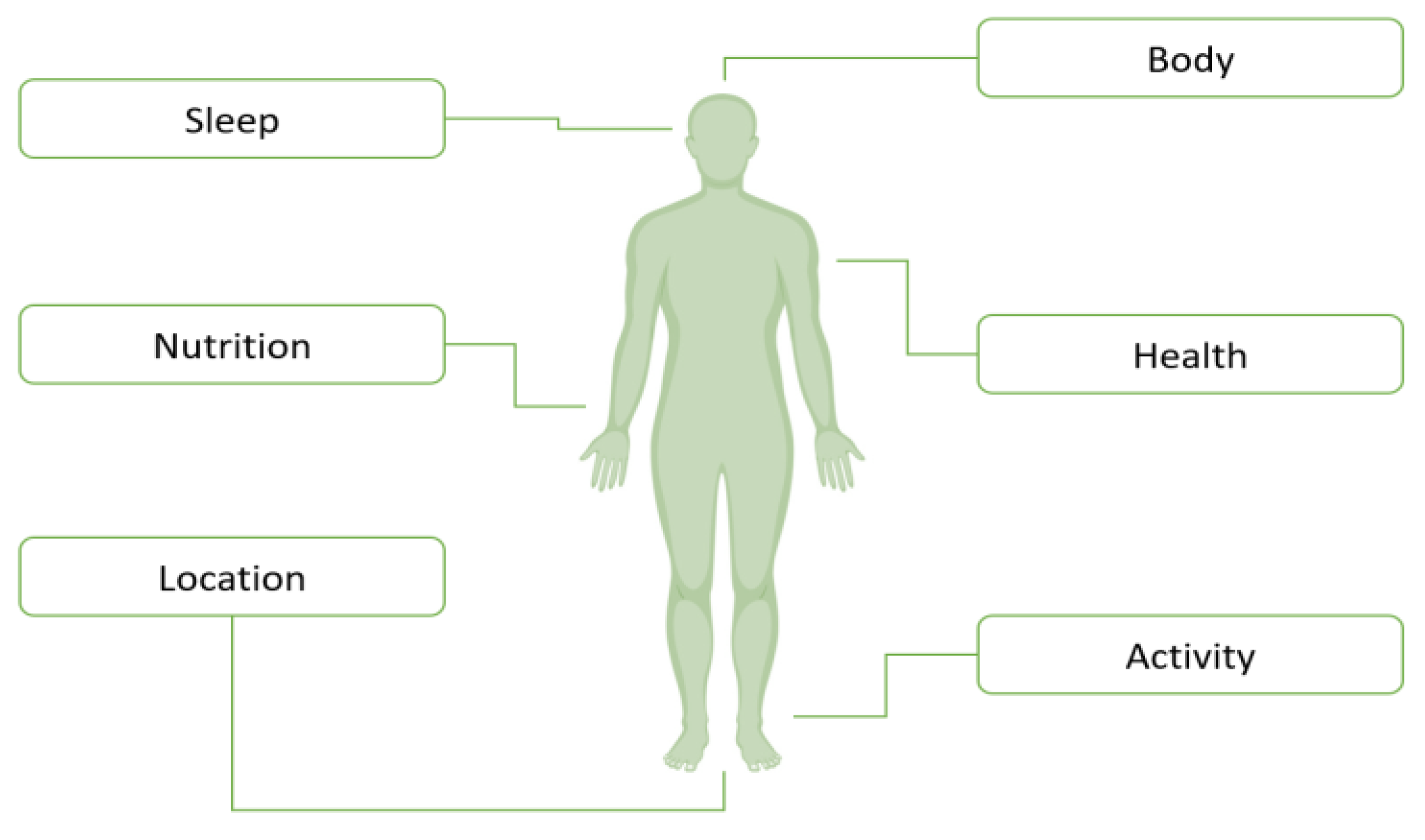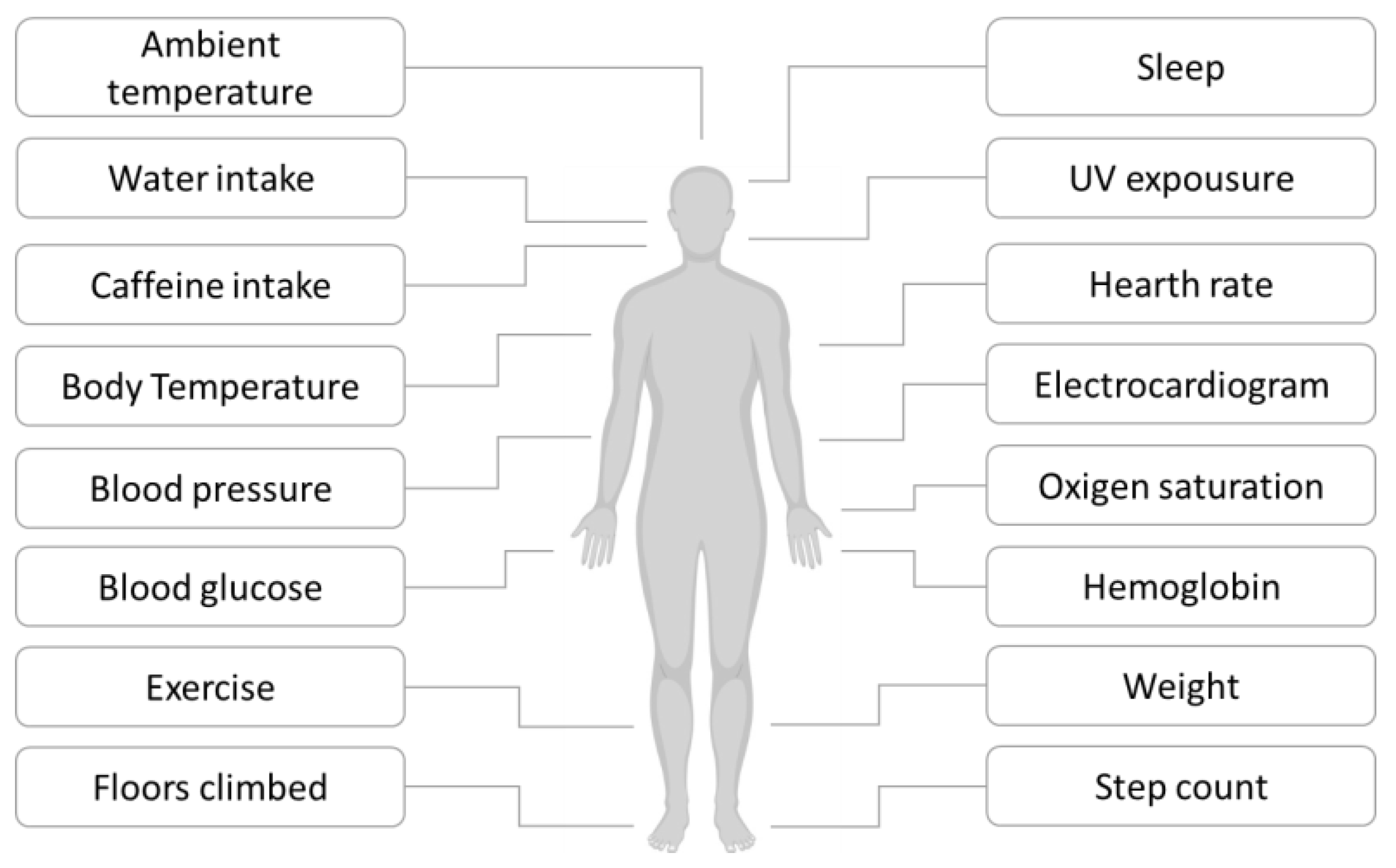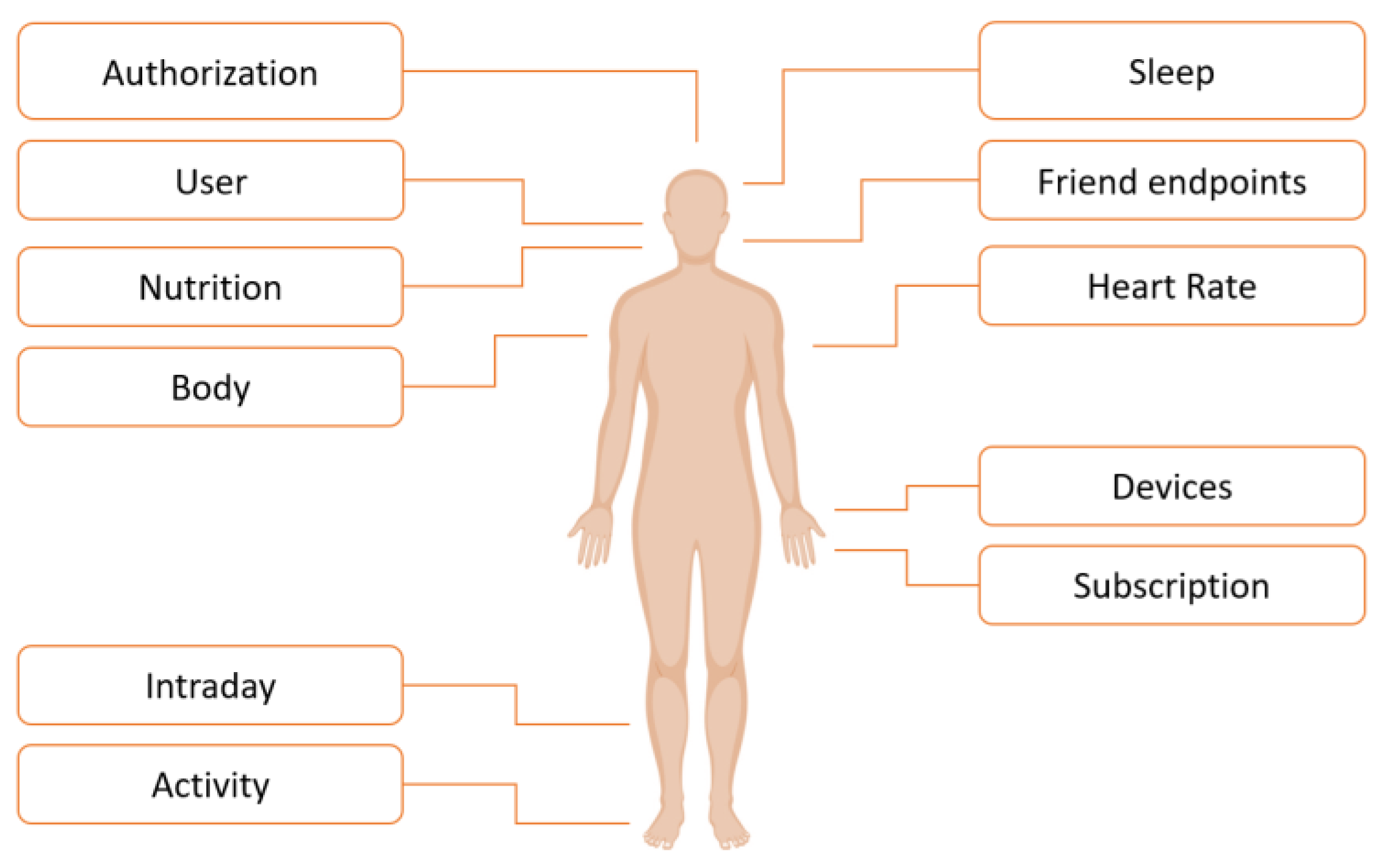You're using an outdated browser. Please upgrade to a modern browser for the best experience.
Please note this is an old version of this entry, which may differ significantly from the current revision.
The main objective of the most popular healthcare platforms, including Apple Health, Google Fit, Samsung Health, and Fitbit, is to provide a well-coordinated, personalized, and satisfying user experience while reducing the overall cost of care. Health platforms can improve the health status of the population by fostering collaboration and integration among the various stakeholders in the health sector. Successful efforts to improve population health require that stakeholders are open and willing to leverage each other’s assets, such as data, skills, and resources.
- cloud-based platforms
- data types
- healthcare
- interoperability and automation
- monitoring
1. Introduction
With the introduction of new cloud-based technologies, it has been possible to develop platforms that can store, manage, or display information of various types. Of course, telecommunications are an important market under which platforms have been developed with the capability to synchronize user information corresponding to contact data so that they can access said data on time and whenever necessary. However, the use of cloud-based platforms goes beyond the storage and management of contact data; now it is possible to take advantage of them to store and access important data for monitoring the activity and physical condition of users. This in turn opens new opportunities to take advantage of the information collected so that timely and remote medical follow-up can be given to users who have some type of medical condition. There are wearable devices and biosensors already on the market that allow remote monitoring of some physical variables associated with various diseases [1], such as wearable devices that allow monitoring of the temperature of the feet in diabetic patients [2]. Likewise, people who are in good health could have the opportunity to monitor their activities and, in certain cases, detect anomalies in their health status. Currently, health platforms focused on storing metrics of the state of the users’ body have already been developed, for example, Apple Health and Google Fit, among others. Of course, the use of these platforms is still in development and at a very superficial stage where users generally manually input the data that are stored on these platforms. Despite this, wearable devices have already been developed that can connect and synchronize with these platforms, which facilitates the automatic feeding of data to them.
On the other hand, interoperability and automation hold great potential as critical enabling technologies for healthcare management, seamlessly integrating into users’ daily routines. While medical-grade wearables are gaining popularity due to their convenience, speed, and provided information, interoperability among automated healthcare processes allows clinicians to focus on tasks requiring specialized expertise, such as diagnosis and treatment. Interoperability enhances efficiency and accuracy, reducing errors in patient monitoring and medication administration while ensuring compliance with regulations. Moreover, it enables prompt access to medical records and up-to-date patient information, leading to more effective resource utilization and faster response to user needs. By fostering the development of efficient, cost-effective healthcare systems, automation can also improve patient outcomes compared to usual treatment goals.
Traditionally, the main goal of medical treatment has been to ensure adherence to the physician’s prescription. Oftentimes the treatment may include appropriate dietary regimens and special lifestyle-related adaptations. Among the activities on treatment management that can be improved through interoperability and automation, the following are of utmost importance:
-
Getting access to electronic health records of patients;
-
Attending various types of prescriptions that vary in the type of decisions required for their application, from those that must be followed punctually as indicated to those that are applied depending on the patient’s changing condition;
-
Alarm setting of crucial biomedical signals of importance for trend analysis;
-
Messaging and reporting patient condition whenever needed;
-
Timely monitoring of user health condition to determine progress to reach therapeutic objectives.
Monitoring, for example, has been conducted through scheduled visits to the physician. However, between visits, there could often be long periods that were inadequate for accurate determination of the patient’s condition, often occurring events that aggravated the patient’s health. In addition, for patients with disabilities or illnesses, the visits represent a serious inconvenience. In contrast, automated remote monitoring permits more precise and opportune surveillance of the patient’s medical condition.
Nowadays, Internet of Things (IoT) medical devices based on healthcare platforms are successfully helping to solve these problems. With these technologies, the period between monitoring has been drastically reduced to measure, analyze, record, and decide on the biomedical signals of interest within very short periods between measurements. Health platforms can become a virtual health surveillance center for the patient where recent patient information is always available with reliable, secure, and shared universal access. On top of them, numerous applications related to the personalized automation of healthcare processes specialized in specific diseases and treatments can be built.
2. Apple Health
This health platform was developed to consolidate crucial health information, making it easily accessible in a centralized and secure location. With the introduction of iOS 15, users can now share data with friends, family, and healthcare teams, assess walking steadiness and falling risk, and analyze trends to better understand changes in their health. The Health app can store and share vital information, such as health records, lab results, activity, sleep, and more. It gathers data from iPhone devices, Apple Watch’s built-in sensors, compatible medical devices, and apps that utilize HealthKit. Designed to ensure data security and user privacy, the Health app stores data on the device and encrypts it, allowing users to have complete control over their health information [3].
Figure 1 shows the types of data types considered in the Apple Health platform, which are:

Figure 1. Data types considered in the Apple Health platform.
-
Characteristic identifiers: data types related to the user characteristics, for example, the user’s activity mode, sex, date of birth, skin type, blood type, or the use of a wheelchair [4];
-
Activity: data types related to the measures of different activities, for example, number of steps, distances moved by walking or running, and strokes performed while swimming, among others;
-
Body measurements: the quantity sample types that measure the body of the user, for example, height, weight, body mass, and body fat, among others;
-
Reproductive health: quantity sample types that record the user’s basal body temperature, cervical mucus, use of contraceptives, menstrual cycles, and sexual activity, among others;
-
Hearing: quantity sample types that measure audio exposure to sounds in the environment, headphones, etc.;
-
Vital Signs: quantity and category sample types that measure the user’s heart rate, irregular heart rhythm events, and standard deviation of heartbeat intervals, among others;
-
Nutrition: quantity sample types for macronutrients, vitamins, minerals, hydration, caffeination, etc.;
-
Alcohol Consumption: quantity sample types that measure the user’s blood alcohol content and the number of standard alcoholic drinks that the user has consumed;
-
Mobility: quantity sample types that measure the steadiness of the user’s gait, the average speed when walking steadily over flat ground, and the speed while climbing a flight of stairs, among others;
-
Symptoms: the category types for symptoms, for example;
-
Abdominal and gastrointestinal symptoms
-
Constitutional symptoms
-
Heart and Lung symptoms
-
Musculoskeletal symptoms
-
Neurological symptoms
-
Nose and Throat symptoms
-
Reproduction symptoms
-
Skin and hair symptoms
-
Sleep symptoms
-
Urinary symptoms
-
Lab and Test Results: quantity sample types that measure the user’s blood alcohol content, blood glucose level, and electrodermal activity, among others;
-
Mindfulness and Sleep: A category sample type for recording a mindful session and sleep analysis information;
-
Self-Care: category sample types for toothbrushing and handwashing events;
-
Workouts: a series sample containing location data that defines the route the user took during a workout;
-
Clinical Records: type identifiers for the different categories of clinical records;
-
UV Exposure: a type of quantitative sample that assesses the user’s exposure to ultraviolet radiation.
3. Google Fit
Google Fit constitutes an open ecosystem permitting developers to transfer health and wellness data to a centralized repository, thereby providing users with the ability to access their information from multiple devices and applications in a single location. Users maintain access to their data upon upgrading to a new device. Health and wellness applications can store information from any wearable or sensor, as well as accessing diverse data types generated by other applications [5].
Figure 2 shows the types of data types considered in the Google Fit platform, which are:

Figure 2. Data types considered in the Google Fit platform.
-
Activity: This data type can capture any activity a user engages in, from common fitness activities like running or sports, to other pursuits such as meditation, gardening, and sleep [6];
-
Body: Data types for standard body measurements;
-
Location: Data types for location information;
-
Nutrition: Data types for nutritional data;
-
Sleep: This data type records the user’s duration and type of sleep. Each data point represents a time interval for a specific sleep stage;
-
Health: Google Fit offers health data types for measurements related to general health management (as opposed to fitness).
4. Samsung Health
Samsung Health offers essential features aimed at improving health. By analyzing exercise and activity history, this platform supports weight loss notifications and encourages a healthy lifestyle. With multiple trackers, users can manage various activities, such as walking, running, cycling, mountain climbing, and indoor and outdoor exercises. Personalized recommendations and exercise regimens are formulated according to tailored settings, assisting users in accomplishing their fitness objectives. The availability of features may vary based on the region, service provider, and device model. Samsung Health is designed solely for the enhancement of physical fitness and health, and is not intended for the diagnosis of disorders or conditions, nor for the cure, relief, treatment, or prevention of disorders [7].
Figure 3 shows the types of data types considered in the Samsung Health platform, which are:

Figure 3. Data types considered in Samsung Health platform.
-
Ambient temperature: This data type defines ambient temperature and humidity data around the device [8];
-
Blood glucose: This data type represents the user’s blood glucose levels;
-
Blood pressure: This data type represents the user’s blood pressure measurements;
-
Body temperature: This data type defines the body temperature data of the user;
-
Caffeine intake: This data type defines the caffeine intake data of the user;
-
Electrocardiogram: This data type defines the electrocardiogram data of the user;
-
Exercise: This data type defines the exercise data of the user;
-
Floors climbed: This data type defines the floor climbed data of the user;
-
Hemoglobin: This data type defines the glycated hemoglobin data of the user;
-
Heart rate: This data type defines the heart rate data of the user;
-
Oxygen saturation: This data type denotes the oxygen saturation levels in the user’s blood;
-
Sleep: This data type defines the sleep data of the user;
-
Step count: This data type defines the user’s step count data. It provides only one month of data;
-
UV exposure: This data type defines UV exposure data around the device;
-
Water intake: This data type defines the water intake data of the user;
-
Weight: This data type defines the weight data of the user.
5. Fitbit
Fitbit offers a collection of public Web APIs that allow developers to access data gathered by Fitbit trackers, smartwatches, and Aria and Aria 2 scales, as well as manually logged data. Developers can utilize these Web APIs for the creation of integrations with Fitbit data services, provided that their applications comply with the Fitbit Platform Terms of Service, Fitbit Platform Developer and User Data Policy, and secure user consent for sharing their data with the developer’s application [9].
Figure 4 shows the types of data types considered in Fitbit, which are:

Figure 4. Data types considered for Fitbit endpoints.
-
Activity: Activity endpoints enable querying and modifying a Fitbit user’s daily activity data, including step count, distance, elevation, floors, calories burned, active minutes, activity goals, exercise details, and more;
-
Authorization: Authorization endpoints help applications onboard Fitbit users who want to share their data. Applications can initiate the consent flow for new users, obtain access and refresh tokens, validate tokens, and revoke user consent. Fitbit supports OAuth 2.0;
-
Body: Body endpoints allow querying and modifying the user’s body fat and weight data;
-
Devices: Devices endpoints display information about devices connected to a user’s account;
-
Friend endpoints: Friend endpoints display information regarding a user’s peers and their respective leaderboard positions;
-
Heart Rate: Heart Rate Time Series endpoints facilitate querying the user’s heart rate data;
-
Intraday: Web APIs can offer a more detailed granularity of data amassed during the day, referred to as Intraday data. This data can be accessed via Activities and Heart Rate Time Series endpoints, with response options for detail levels comprising 1-min and 15-min intervals for activity, and 1-s and 1-min intervals for Heart Rate;
-
Nutrition: Nutrition endpoints enable querying and modifying food and water data.
-
Sleep: Sleep endpoints help query and modify sleep data;
-
Subscription: Subscription endpoints allow applications to subscribe to user-specific data. Fitbit sends webhook notifications to inform applications of new user data, eliminating the need for applications to poll services;
-
User: User endpoints display user profile information, regional locale, and language settings, and collected badges.
Irrespective of the selected health platform, the storage and sharing of health data type values are crucial in facilitating coordination among healthcare providers, conserving time and resources, promoting medical research and development, assisting public health monitoring, and reinforcing interoperability between healthcare systems, all of which are essential factors in enhancing patient care.
This entry is adapted from the peer-reviewed paper 10.3390/informatics11010002
References
- Kim, J.; Campbell, A.S.; de Ávila, B.E.-F.; Wang, J. Wearable biosensors for healthcare monitoring. Nat. Bio-Technol. 2019, 37, 389–406.
- Martín-Vaquero, J.; Hernández Encinas, A.; Queiruga-Dios, A.; José Bullón, J.; Martínez-Nova, A.; Torre-blanca González, J.; Bullón-Carbajo, C. Review on wearables to monitor foot temperature in diabetic patients. Sensors 2019, 19, 776.
- iOS—Health—Apple. Available online: https://www.apple.com/ios/health/ (accessed on 6 August 2023).
- Data Types | Apple Developer Documentation. Available online: https://developer.apple.com/documentation/healthkit/data_types (accessed on 6 August 2023).
- Google Fit. Available online: https://www.google.com/fit/ (accessed on 6 August 2023).
- Data Types | Google Fit | Google Developers. Available online: https://developers.google.com/fit/datatypes (accessed on 7 August 2023).
- Samsung Health | Apps—The Official Samsung Galaxy Site. Available online: https://www.samsung.com/global/galaxy/apps/samsung-health/ (accessed on 7 August 2023).
- Samsung Health Android SDK—Data API Reference 1.5.0 | Samsung Developers. Available online: https://developer.samsung.com/health/android/data/api-reference/overview-summary.html (accessed on 7 August 2023).
- Web API. Available online: https://dev.fitbit.com/build/reference/web-api/ (accessed on 7 August 2023).
This entry is offline, you can click here to edit this entry!
